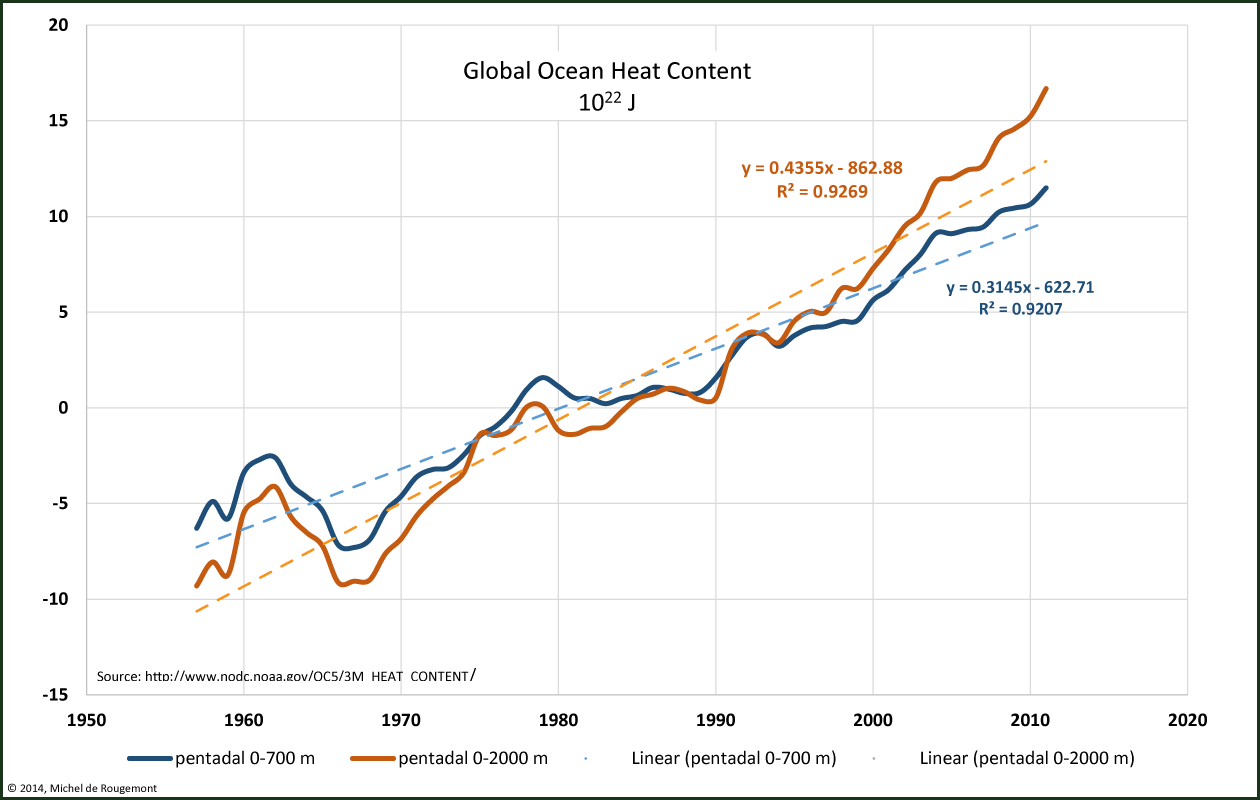Considering that the total amount of water on Earth is almost constant, seas and oceans contain all water that is not in the atmosphere, in form of ice sheet or glaciers, kept in lakes, streams and in the ground, or retained by flora and fauna.
At the last glacial maximum, about 21’000 years ago, it is estimated that the sea level was approx. 125 meter lower than it is today.
The hypothetical melting of the ice sheets of the Antarctic and of Greenland would imply a further rise of approx. 82 meter. So far are we not, since the current ice loss of these two land masses corresponds to a sea level rise of 0.9 mm/a.
Other factors influencing the change of sea level is its thermal dilatation due to temperature change, and the changes of the volume of ocean basins due to geological shifts and deposits of sediments.

Global average sea level.
Source: John A. Church, Neil J. White, “Sea-Level Rise from the Late 19th to the Early 21st Century”, Surveys in Geophysics, Volume 32, Issue 4-5 , pp 585-602
and Jevrejeva, S., J. C. Moore, A. Grinsted, and P. L. Woodworth, "Recent global sea level acceleration started over 200 years ago?" (2008), Geophys. Res. Lett., 35
The rise rate is fluctuating in a multi-decadal way (green line on the preceding graph), similar to the Atlantic oscillations.
It should be noted that the sea level seems to have begun to increase at a rate of approx. 2.4 mm per year as early as at the end of the 18th century, before the industrial era, in line with the end of the Little Ice Age, with an acceleration from ~1.3 to ~1.9 mm per year over the past century.
Recent measurements and evaluations have led to the short term conclusion that over the past 50 years the oceans were globally accumulating heat at the rate of 4.43 zettajoules (1021) per year, which corresponds to a net heat flux of 0.38 W m-2 over the ocean surface.
I cannot judge the quality of these evaluations, but considering that 1 m3 of water has a 4000 times larger heat capacity than 1 m3 of air, this implies that annual ocean temperature variations of a few thousands of degree (0.001 °C) must be recorded; and knowing that temperature measurements are made by Argo floats with a 0.005 °C accuracy, it cannot be expected that such heat fluxes are set in stone. In addition, such records are 55 years young; Argo floats are in service since only 2000.
Nevertheless, it can be logically expected that if the atmosphere is warming and ice sheet melting, some net heat transfer to the water mass of the oceans will result. But other heat and mass exchange mechanisms are taking place simultaneously: convective with more or less humid and warm air, evaporative, and radiative in the short and long wave ranges. Such transfers involve energy fluxes of much higher orders of magnitude. This will be looked at later in the modelling section.

Heat accumulation in the oceans in layers of 700 m and 2000 m depth.
Sources: NOAA
Even a tiny temperature increase of the ocean has an effect on the sea level. The heat accumulation of 4.43 ZJ a-1 will warm a 2000 meter deep water column by 0.0015 °C each year. At 10 °C, with a thermal expansion coefficient of water is 0.000088 K-1, the sea level will be raised by 0.26 mm per year.
This is just a rough example, providing plausible orders of magnitude. In comparison, as seen in the previous chapter, the current melting of the Greenland and Antarctic ice sheets contributes by 0.9 mm per year to the rise of the sea level.


